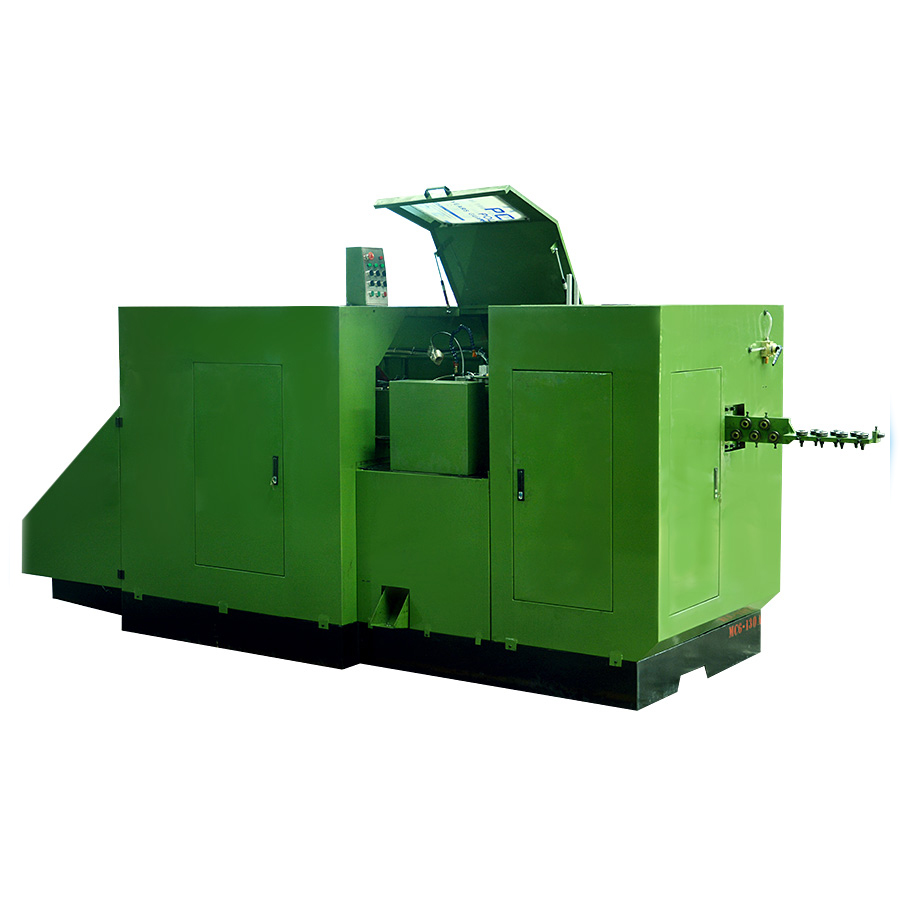
4-Die 4-Blow Cold Heading Machine
The 4-Die 4-Blow Cold Heading Machine is a specialized type of forming equipment used in the manufacturing industry, particularly for producing fasteners, bolts, screws, and other small metal components.
It is designed to form and shape metal blanks into finished products through a series of four distinct forming operations, each performed by a separate die station. The term "cold heading" refers to the process of shaping metal at room temperature without the need for heating, which allows for high-speed production and minimal material loss.
4-Die 4-Blow cold heading machines are widely used in industries such as automotive, construction, and electronics for the mass production of fasteners, pins, and other precision metal components.
1. Material Preparation
Before the process begins, the wire stock needs to be prepared. This involves ensuring the wire is straightened, cleaned, and lubricated if necessary. The wire is fed into the machine through a guide system.
2. Cutting
The wire is measured to the correct length for the desired part and then cut using shearing blades. Precision is critical here to ensure consistent part lengths.
3. Feeding
After the wire is cut to the right length, it is fed into the forming area. This is often done automatically, with the machine designed to handle continuous feeding.
4. Forming/Heading
In the forming stage, the wire blank is positioned under the punch and die set. The punch moves down and compresses the wire against the die, which has the negative shape of the desired part. This process is called heading and can create features such as heads, hexagonal shapes, or countersunk forms.
5. Cold Forming
During cold heading, the wire is deformed at room temperature, which allows for the creation of intricate shapes without melting the material. This process increases the strength and durability of the formed parts due to the work hardening effect.
6. Secondary Operations
Depending on the complexity of the part, secondary operations might be necessary. These could include broaching, chamfering, threading, or knurling. These steps are performed using additional tools mounted on the machine or in separate machines.
7. Ejection
Once the part is fully formed, it is ejected from the die using a pusher or ejector mechanism. The finished parts are collected and may go through further processing such as cleaning, coating, or packaging.
8. Quality Control
Throughout the operation, quality control measures are taken to ensure the parts meet the specified dimensions and tolerances. This can involve visual inspection, measurement, and testing of the mechanical properties of the parts.
Key Features of Operation:
Automation: Modern 4D4B machines are highly automated, reducing the need for manual intervention.
Precision: They are capable of producing parts with high precision and repeatability.
Efficiency: These machines can produce a high volume of parts per minute, making them suitable for mass production.
Maintenance and Safety Considerations:
Regular Maintenance: To keep the machine running smoothly, it is important to follow a maintenance schedule that includes lubrication, cleaning, and checking tool wear.
Safety Protocols: Operators must follow strict safety protocols, including wearing protective gear and adhering to operational guidelines to prevent accidents.
Automotive Industry:
Fasteners: Production of nuts, bolts, screws, and rivets used in vehicle assembly.
Connector Pins: Manufacturing of pins, clips, and other small components for electrical and mechanical connections.
Engine Components: Small engine parts, such as retaining rings, spacers, and clips.
Construction Industry:
Fasteners: Bolts, nails, and other fasteners used in building and construction projects.
Fixings: Clips, brackets, and other fixings required for structural and non-structural applications.
Electronics Industry:
Electrical Connectors: Pins, terminals, and other connectors used in electronic devices and circuit boards.
Precision Components: Small metal components for consumer electronics, such as mobile phones and computers.
Aerospace Industry:
Fasteners: Specialized fasteners with tight tolerances and high-strength requirements for aircraft and spacecraft.
Mechanical Components: Small components for aerospace systems, such as bearings and clips.
Medical Industry:
Surgical Instruments: Precision components for surgical instruments and medical devices.
Implants: Small metal implants, such as screws and pins used in orthopedic surgery.
Hardware and Tool Industry:
Tools: Production of tool components, such as bits, fasteners, and handles.
Hardware: Nuts, bolts, screws, and other hardware items for general use.
Specific Products
Some common products that can be manufactured using a 4-Die 4-Blow cold heading machine include:
Bolts and Screws: Various types of bolts and screws with different head styles, such as hexagonal, pan, button, and socket cap heads.
Nuts: Hexagonal nuts, flange nuts, and other specialized nuts.
Washers: Plain washers, lock washers, and specialty washers.
Pins and Studs: Straight pins, safety pins, and threaded studs.
Clips and Retainers: C-clips, snap rings, and other retaining elements.
Connectors: Electrical connectors, such as pins and sockets.
Bearings: Small ball bearings and other bearing components.
















































